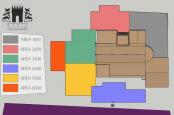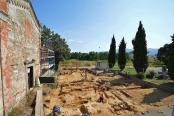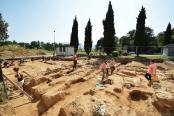CAMPAGNA 2016 |
1° SETTIMANA |
2° SETTIMANA |
3° SETTIMANA |
4° SETTIMANA |
5° SETTIMANA |
6° SETTIMANA |
27 GIUGNO 2016 
Resoconto della giornata di scavo
Generale
Inizierà lunedì 27 giugno 2016 la sesta campagna di scavi a Badia Pozzeveri. Dopo gli straordinari risultati della scorsa estate, le ricerche riprendono da dove si sono fermate, per approfondire la conoscenza dei livelli archeologici dell'abbazia medievale ed esplorare i contesti cimiteriali attorno alla chiesa di San Pietro. Terminate le indagini delle aree 1000 e 4000, poste rispettivamente in prospicienza dell'abside e del chiostro, gli scavi andranno ad investire i seguenti saggi:
- Area 2000: posta lungo il perimetro nord della chiesa, investe un cimitero che ha dato alla luce in questi anni un enorme campione scheletrico di oltre 150 individui, tra cui 8 colerosi del 1855.
- Area 3000: è stata aperta di fronte al fronte della chiesa e ha permesso il ritrovamento delle antiche facciate medievali, di fosse fusorie per le campane e di numerose sepolture moderne e medievali.
- Area 5000: aperta lo scorso anno tra le aree 3000 e 4000, insiste sui contesti relativi agli ambienti del monastero.
- Area 6000: è il nuovo saggio, aperto immediatamente a ovest di Area 3000. Avrà lo scopo di investigare le strutture legate all'edificio sacro e funzionali alla vita del cenobio.
Dal 27 giugno aggiornamenti quotidiani su queste pagine!

Area 2000
Today Area 2000 opened the site after one year of closure. Our area, located on the north side of the site, contains the bodies from victims of cholera in the 19th century epidemic that ravaged Lucca province and bodies from Medieval era burials, located further below ground. We removed the tarps covering the area, and began cleaning the site - ie: using trowels to go over each inch of dirt and remove the dry soil and leftover plant detritus. After our first round of cleaning, we examined the area for possible grave sites and began a second round of cleaning to more specifically reveal the layout of about half of the current excavation area. Our work tomorrow will focus on finishing this cleaning process and examining the topography and stratigraphy. While we did find some bones today, most of what we recovered is bits and pieces from several individuals, including a child. Our second round of cleaning has thus far uncovered several possible leads into where we might start excavating bodies as we work to finish the 19th century graves and dig further down to reach the Medieval burials.
Area 3000
Excavation crew opened the site (Area 3000 is devided into Sectors A & B) removed vegetation, cleaning of the entire site. We cleaned the area know That there would be a clearer understanding of the context of the site. In the process of removing the tarp covering, we removed surface human bone fragments, Which were collected in bags and artifact Submitted to Site Supervisor. Complications arose When there were three wasp nests, large spiders, one snake, and many rhinocerous beetles. Preparing the next day to commence proper excavation of each grave site.
Area 5000
This morning area 5000 worked on the south side of Badia. The time before lunch was spent preparing our area for the removal of the post-season ground cover by digging away the dirt and pulling up all of the existing vegetation. After wich we removed the ground coverings and prepared them to be used again at the end of the current field season. Removing the ground cover exposed several features including: an ancient wall (date unknown) believed to a remnant of housing or out-buildings for the monetesary's conversi, a bronze bell foundry dating to the 12th or 13th century, and the large post holes of a structure most likely dating to the modern age. After which, our crew completed the initial site cleaning to allow for additional insight and excavation.
Area 6000
This morning, after breakfast, the students gathered in the cafeteria for orientation. During this time, we learned the history of the site and the direction of the course. After this, we headed to the site. Our first objective was to clean off the excess dirt and weeds on the tarps in order to pull them off the area. Once our area was cleared, we troweled the loose dirt off the site and discovered exposed bone at the the top layer of soil. Additionally, we had a lecture by our supervisor Ale which discussed the features of the site that had been previously discovered. We also got our first look at photogrammetry. Tomorrow, we must finish cleaning the south end of our area and start our excatvation!











